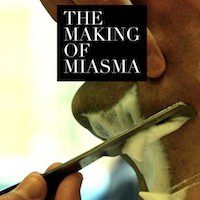A psychedelic drug is a rootkit for the human machine. Swallow the right poison at the proper dosage under the prescribed conditions of doctor or dealer and you may experience the illusory kicks of control. It is as if by some secret backchannel coding you can hack through the holes in our system, modify your mind and mood like rudimentary C++. You may believe that the user has become the administrator. You may believe that the computer really is wearing tennis shoes.
Such mind-bending compounds and the delusions they produce are at the center of Henry Escaya’s debut novel The Making of Miasma, threading the joint terrors of freedom and dependence through a tight, unusual sci-fi narrative. Escaya’s alt-contemporary America is one in which synthetic drugs are popularized to the point of mass market utility, wherein whole attitudes and intelligences are distilled into 500mg capsules and pushers remark that “people don’t come… asking for a drug, they come with a problem.”
Our point man down this hallucinogenic rabbit hole is Maxwell Chambers, a disgruntled former New York ad exec now caught up in the perpetual hunt for his next chemical high and personal low. Chambers is hooked on Cerulean (street name: “Ceru”), a different sort of little blue pill that elevates the brain’s capacity for pattern recognition, inducing a new “clarity of… systems” and a heightened sensitivity to the fixed social calculations that drive our behavior. It is also, as Chambers learns, classified as a Schedule I substance.
Upon arrest for possession, he is offered a choice: conscription into the U.S. Army or enrollment in a government drug trial. Chambers chooses the trial. The drug administered is known as Dobrom (street name: “Dobro,” which is a bit lacking in punch for a sinister dystopian superdrug, and certainly no “Soma” or “Kallocain”). The G-Men sell Chambers on Dobro as a cure for addiction, but in truth its effects are not unlike those of Ceru, fostering hyperawareness and extreme mental acuity on the part of the user, while giving visual expression to human predestination in the form of long, white Donnie Darko-style timelines extending outward from each individual body from birth to death.
Dobro is a harrowing invention, its most dreadful feature the very permanence of its effect. One take and the user is hooked for life, the bottom line of their psychological balance irrevocably transformed. Addicts surrender all other aspects of their selves: first food, then sleep, then the possibility of any relationship not sustained by the desire to spread Dobro addiction to others. It is a neurological cancer masking itself as a new religion, metastasizing from person to person with missionary fervor across the streets of New York, and Chambers is at once its core malignancy and high priest.
By Miasma’s midpoint, Chambers has assembled an apostolic congregation of junkies and burnouts around his cult of personality. He has merged the paternal charisma of Charles Manson with the Angry Young Lab Rat self-seriousness of Alex DeLarge. Like Saul to Paul, he reinvents himself through the name “Mac Miasma” and devotes the totality of his days to the moving of product, the drafting of manifestos and the coming Helter Skelter of the Dobro Revolution, a threat as real as it is imagined. Chambers is a bit of a Solipsistic narrator – his fixations are so erratic and the drugs in his system so potent that it is difficult to trust anything outside his own existence as true. This is both an exciting and frustrating revelation.
Escaya’s strong portrayal of drugs as enhancement to and corruption of humanity’s mental programming is reminiscent of Philip K. Dick’s paranoid autobiographical fantasy A Scanner Darkly, the later work of William Gibson and cyberpunk magnum opus The Matrix, which I’ve recently realized – almost fifteen years too late – is less about evil robots and the inherent coolness of leather jackets than it is an extended allegory for tripping on LSD. Escaya’s nightmare is effective because it latches onto the truest anxiety across all the altered states, the great fear that Huxley’s famous Doors of Perception might function more like the doors of a Scooby-Doo hallway: that the further you walk, the deeper you get, the harder it is to find your way back from the void. In the words of David After Dentist, “Is this going to be forever?”
The Making of Miasma is a terse novel, too fraught with ideas to fit into its 57,000 word container. Extraordinary sci-fi concepts are introduced and then discarded without ever being granted the chance to achieve their full resonance. An ambiguous war with a terroristic Middle Eastern adversary, genetically superior super-police, unpredictable bombs capable of rending any given acre of the national landscape with sinkholes, a society of presidentially-influenced gentlemen freedom fighters who operate as a geopolitical extension of Patrick Swayze’s gang from Point Break… all of these conceits could well function as the basis for their own novels, yet are given short shrift here, in a work that falls well under the median word count for wide-scale publication. The result is a manic, blitz-quick story that doesn’t always seem to have its head put together. It feels like Escaya has gifted us ice cream without the cone, a fortune without the cookie.
In all, The Making of Miasma is a fascinating first novel, rich with creativity but lacking the pace and focus to impress beyond its immediate cleverness. Where it fails, it hits like a soft withdrawal, a steady buzz of prose ringing between your ears. But where it succeeds, it’s one hell of a high.




